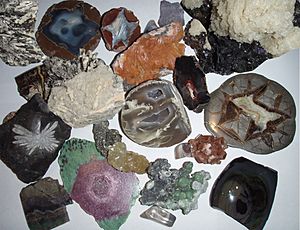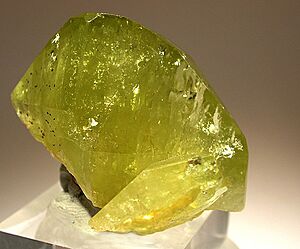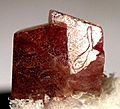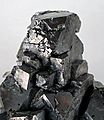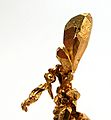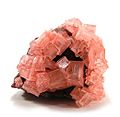Mineral facts for kids
Minerals are special substances found naturally in the Earth. Think of them as Earth's building blocks!
Most minerals are solids. They are also usually inorganic, meaning they don't come from living things. Minerals have a special, organized internal structure called a crystal structure. They form naturally through Earth's processes.
The study of minerals is called mineralogy.
A mineral can be made of just one chemical element. But most minerals are made of a mix of elements, forming a compound. There are more than 4,000 types of minerals known today! Some common ones you might know are quartz and feldspar.
Contents
What Makes a Mineral a Mineral?

A substance is usually a mineral if it:
- Is a solid. (But there are a few exceptions, like liquid mercury!)
- Is inorganic, meaning it's not from plants or animals.
- Has a specific chemical recipe. This means it's always made of the same elements in the same amounts.
- Usually has a crystal structure. This means its atoms are arranged in a neat, repeating pattern.
- Forms naturally through Earth's processes.
Minerals and Rocks: What's the Difference?
It's easy to mix up minerals and rocks, but they are different!
A mineral is like a pure ingredient. It has a specific chemical makeup and a defined crystal structure. For example, a ruby is a mineral. So, a ruby found in India will have the same chemical makeup as a ruby found in Australia.
A rock, on the other hand, is usually a mixture of one or more minerals. It's like a cookie made with different ingredients. A rock is a solid and forms naturally, just like minerals. But two pieces of the same type of rock might have different amounts or kinds of minerals in them.
Types of Rocks
There are three main types of rocks. They are formed in different ways.
- Igneous Rocks: Born from Fire!
These rocks are formed when hot, melted rock cools down and hardens. Melted rock inside the Earth is called magma. When it comes out onto the surface, it's called lava. "Igneous" comes from a Latin word meaning "fire."
Examples: Granite and basalt are common igneous rocks. Granite is often used for kitchen counters. Basalt makes up much of the ocean floor.
- Sedimentary Rocks: Layers of History!
These rocks are made from tiny pieces of other rocks, minerals, or even old plants and animals. These tiny bits are called sediment. Wind and water carry sediment and drop it in layers. Over a long time, these layers get pressed and glued together to form sedimentary rock.
Examples: Sandstone, limestone, and shale are sedimentary rocks.
- Metamorphic Rocks: Rocks That Change!
These rocks are rocks that have been changed by heat and pressure. "Metamorphic" means "to change form." When rocks are buried deep inside the Earth, they get squeezed and heated. This can change their minerals and how they look, creating a new type of rock!
Examples: Marble and slate are metamorphic rocks. Marble is formed from limestone and is used for sculptures. Slate is formed from shale and is used for roofing.
Ores
Ores are special minerals that have a lot of a certain element, usually a metal. People dig up ores to get these valuable elements.
Examples: Cinnabar is an ore used to get mercury. Sphalerite is an ore for zinc.
Gems
Gems, also called gemstones, are beautiful, rare, and strong minerals. People have loved gems for thousands of years! They are often used in jewelry and other decorations.
Examples:
- Diamonds: These are the hardest natural substance known. They are made of pure carbon.
- Rubies: These are red gemstones. They get their red color from the element chromium.
- Sapphires: These are also made of the same mineral as rubies, but they come in many colors like blue, pink, and yellow.
- Emeralds: These are green gemstones. Their green color comes from chromium or vanadium.
- Amethysts: These are purple gemstones. They get their purple color from iron.
How Minerals Form in Nature
Minerals are formed by natural processes. For example, the mineral halite, which is table salt, forms when water evaporates from a hot, shallow part of the ocean. This leaves the salt behind.
Many minerals are made when molten rock, or magma, cools down and turns into a solid. Talc, which is used to make baby powder, forms deep in the Earth. It forms when high pressure and temperature change solid rock.
Some minerals are even formed because of life on Earth! For example, the shells of molluscs are made of minerals like calcite.
Minerals are Solids
A mineral is a solid. This means it has a definite size and shape. For example, a golf ball has a smaller size than a baseball.
A substance that is a liquid or a gas is not a mineral. However, its solid form might be. For instance, liquid water is not a mineral, but ice is!
Mineral Properties
Scientists use different properties to identify minerals. Here are some important ones:
- Crystal Structure: This is the organized, repeating pattern of atoms inside a mineral. Each mineral has its own unique crystal structure. For example, both diamond and graphite are made of just carbon. But their atoms are arranged differently, making diamonds very hard and sparkly, while graphite is soft and gray.
- Hardness: This is how easily a mineral can be scratched. The Mohs scale measures hardness from 1 (softest, like talc) to 10 (hardest, like diamond).
- Lustre: This describes how a mineral's surface reflects light. Does it look metallic, glassy, or dull?
- Colour: The color of the mineral itself.
- Streak: This is the color of a mineral when it's ground into a fine powder. You can test this by rubbing the mineral on an unglazed plate.
- Cleavage: This is how a mineral breaks along smooth, flat surfaces.
- Fracture: This is how a mineral breaks when it doesn't follow its natural cleavage planes. It might break unevenly or in jagged pieces.
- Specific Gravity: This is how dense a mineral is compared to water.
- Other Properties: Some minerals have unique properties, like being magnetic or glowing under ultraviolet light.
Chemical Makeup of Minerals
Every mineral has a specific chemical makeup. It's made of a certain combination of elements. An element is a substance that has only one type of atom.
Scientists group minerals based on their chemical makeup. Even though there are thousands of minerals, only about 30 are very common in Earth's crust. These are called "rock-forming minerals."
- Silicates: This is the most common group. All silicates contain oxygen and silicon, which are the two most common elements in Earth's crust. They can also include other elements like aluminium or iron. Quartz, feldspar, and mica are common silicates.
- Carbonates: This is the second most common group. All carbonates contain carbon and oxygen joined together. Calcite, found in seashells, is a carbonate mineral.
- Oxides: These minerals are made of an element (usually a metal) joined to oxygen. Many metals, like tin and copper, are refined from oxide minerals. Hematite is an oxide that is a source of iron.
- Sulphates: These minerals contain a special group of atoms called SO4. Sulphates often form when very salty water slowly dries up. They can also form when hot water flows through rocks.
There are many other groups of minerals too!
Some Uses of Minerals
People use minerals every single day!
- The copper in the wires that carry electricity to your TV or microwave comes from a mineral.
- Table salt (halite) is a mineral we use in cooking.
- Graphite is a mineral used to make pencils.
- Mineral ores are the source of many important metals.
Images for kids
-
Schist is a metamorphic rock with many flat minerals. This example has large sillimanite crystals.
-
Kaolinite formed in the shape of orthoclase it replaced.
-
Topaz has a unique elongated crystal shape.
-
Contact twins, as seen in spinel.
-
Pyrite has a metallic shine.
-
Galena, a mineral with a high specific gravity (it's very dense).
-
Carnotite (yellow) is a radioactive uranium-bearing mineral.
-
Sphalerite crystal partly covered in calcite.
-
Pink cubic halite (salt) crystals on a nahcolite matrix (a mineral form of baking soda).
See also
 In Spanish: Mineral para niños
In Spanish: Mineral para niños


